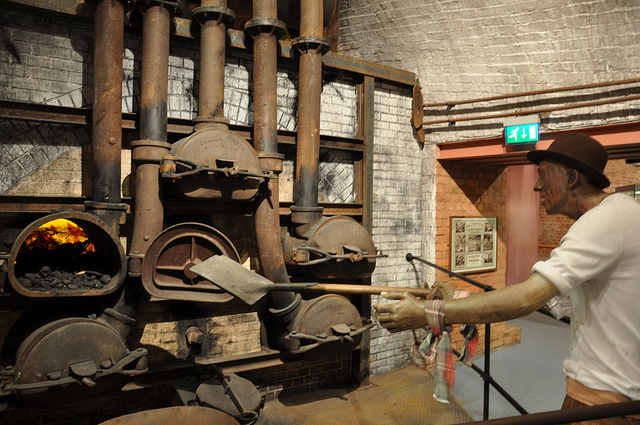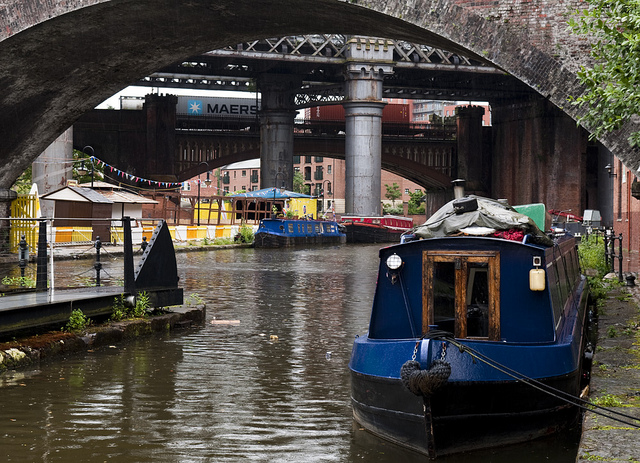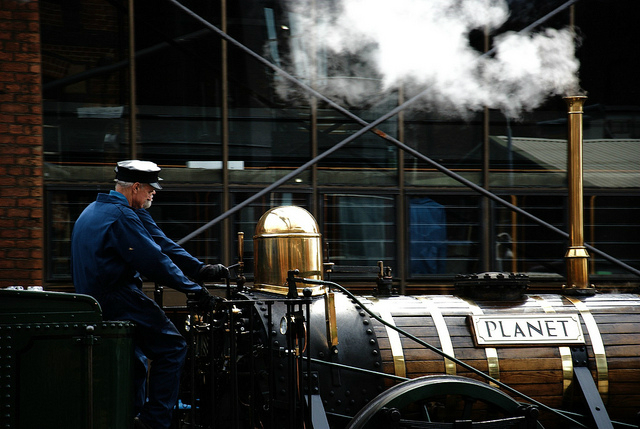Manchester’s Museum of Science & Industry is more than just a day out, it’s an appraisal of the industrial revolution in conjunction with the region of Greater Manchester. A visit will leave you with knowledge you never expected you would learn.

Museum of Science and Industry, Manchester (Photo: J. Boyer via Flickr)
Sewers are not usually the place one expects to learn something interesting. However, Manchester is a place that is full of surprises, many of which are contained within, and beneath, the walls of the Museum of Science & Industry. Water burbled all around me. Through purpose-built red brick channels and into old porcelain, the water was coaxed along by the craftwork of countless inventors, engineers and builders. The sound of flushing toilets echoed through the vaulted walkways, mingling with my solitary footsteps.
The museum is vast and sprawls through a number of large former warehouses. I had somehow ended up in the Underground Manchester gallery. Having arrived just as they opened, and it being a weekday, I was alone in the sewer – which was recreated using the original bricks, hopefully after being thoroughly sanitised, of a former sewer in Manchester from the early 19th century.
At this juncture I feel I should clarify something: the museum, known affectionately by its acronym MOSI, is not solely dedicated to the elucidation of human waste management’s glorious history. This is just a part of a series of permanent exhibitions charting the multifarious achievements of human industrial and scientific endeavour in the Greater Manchester region over the past three centuries. And it is not long before one realises that Manchester was one of the most important places in the world in driving humanity rapidly into an urbanised and industrially developed era.
Water Great Idea
Whilst it would be impossible to list all of the innovations and inventions in engineering, textiles, design and more in the region, one thing seemed to strike me as a constant linchpin throughout – the manipulation of water. Not only with the creation of sewers – which the Roman empire had brought to England and the settlement of Mamucium, which stood roughly where the museum is today – but also the exploitation of water in new technology.
Water has been relied upon heavily for some of man’s greatest achievements. This legacy remains etched throughout Castlefield, the small region of Manchester close to the city centre where MOSI is located. Stroll across the road from the museum and you are beside Bridgewater Canal – the first canal in the world to be used for industrial purposes in 1761. It was along this canal that coal was shipped from mines in Worsley to the factories of Manchester.
Wandering along the banks of the canal in the early morning, I had been greeted by a number of friendly folk. Jeremy was one of them. He lives on the canal. His home is a 56ft narrowboat called Gladys. For well over a century the canal system in Britain has been the domain solely of the pleasure seeker.

Castlefield Canal’ – The canal is both a site of leisure and a home today. (Photo: Joe Dunckley via Flickr)
“There was a time that they called ‘canal mania'” he told me. “After this canal was so successful financially, they began building them all over Britain until the trains came along.” His little Jack Russell, who also lives on the narrowboat, bounded onto the tow path and sniffed around one of the large pillars of the now disused Castlefield viaduct. Trees were growing through the metal latticework of the beautiful structure because nobody could agree what to do with it now that it has become obsolete. “Manchester has really turned around in the last decade” Jeremy told me. “Even before the Commonwealth Games, things had started to improve”. His Jack Russell was busy marking his territory on somebody else’s narrowboat. “But there is still a lot left over that they are doing nothing with” he said, pointing up at the bridge. “They were talking about making one of those hanging gardens like they have in New York, but nothing came of it.”
Jeremy had made the waterways his home, simply moving on when he became tired of one view from his window. Had we been chatting here 250 years ago, the shire horse that used to pull the barges along might have been grazing on grasses growing near the tow path, and his vessel would be laden with coal. Now, all I could see through the window was a guitar and a loaf of bread.
Full Steam Ahead
Back in the 19th century, the improvement of transport was central to the emergence of Manchester. The city had started to grow as a centre of industrial development well before the perfection of the internal combustion engine, which was not effective enough to be used commercially until 1858. Therefore another form of water manipulation – steam power – allowed the city’s growth to continue with little restraint.
Ascending from the reconstructed sewer, I emerged from the building to find myself stood on the platform of Liverpool Road train station. This was another first for the world. From this spot in 1830, the first people to ever ride a passenger train disembarked for Liverpool. Once again, it was water and coal that made it possible. A year earlier, George and his son Robert Stephenson won the Rainhill Trials near Liverpool. Their entry into this seminal competition was Rocket and it was the only steam locomotive to complete the one mile course, thus winning them the contract to produce more locomotives.

The Planet’ – A replica of the first class of commercial locomotives in operation. (Photo: Lucy Bridges via Flickr)
The platform was quiet now. The rails no longer vibrated with the passage of the steel beasts they once conveyed. Passengers now leave the elegant and modern Piccadilly station for Liverpool. But stood on the old platform, no higher than the rails themselves, with my feet planted on the old, wooden floorboards, I could feel the excitement of rail travel again. Today, taking the train can be stressful, the stations crowded with rushing commuters and dallying tourists. Shops and kiosks sell overpriced items, electronic boards make it impossible to get lost and the general fanfare of travel is lost to the past.
I tried to imagine what those first passengers were thinking as the train chugged up to the platform, plumes of white steam pouring into the sky. Despite the countless trains I have taken in my life, I had never truly appreciated the marvel of human ability that makes them possible. Let alone the feat that makes them run (mostly) on time. I suppose the feeling people had in 1830 was something akin to how we perceive today’s imminent commercial space travel. The principles are the same; the boundaries are wider.
The innovation that took place in Manchester paved the way towards demolishing all notion of frontiers. I doubt that the Stephensons imagined that less than a century and a half since they invented a locomotive that could take passengers from one town to another 30 miles away, humans would be leaving the planet for the sky and beyond.
The Hour of Power
The evolution of the use of steam in industry is perfectly articulated in the Power Hall at MOSI. I wandered back along the train tracks towards it. Outside the Power Hall, two white haired gents in navy blue coveralls were attending to a replica of a Planet class locomotive, much like the first ones that ever plied these rails carrying passengers. The intricacy makes the locomotive a thing of real beauty. Smoke trickled from its black snout, which protruded up from its rotund wooden body, bound by hoops of brass like an overturned, regal ale cask. Inside, the coal fires burn, heating the water around the firebox, breathing steam. The steam collects in the brass dome at the top and is pushed at high energy through cylinders to drive the pistons and move the locomotive forwards.
Inside the Power Hall, a plethora of steam-driven mill engines hissed and clattered; the largest collection of working steam mill engines in the world. I wandered between a beam engine and a pumping engine, having no idea what they were or did before. Passing from one engine to the next, the room opened up to house locomotives. From replicas of the first ever trains, to locomotives built before electricity and diesel fully took over, the collection highlights some of the major advances in technology. The Beyer-Garratt articulated steam locomotive is the most impressive. This huge engine was made in 1930 and was used in South Africa until 1972. I was reminded that some of the steam locomotives built in Britain at the time are still in operation today. I rode one of the them in the Indian Himalayas up to the hill station of Darjeeling, which was built in 1889 and still runs.
In the next warehouse over at MOSI is the Air & Space gallery. A natural progression to the developments of the Victorian era. Despite this, Manchester had entered an economic decline by this time. With the fall of heavy industry at the end of the Victorian era came the demise of the north, but nevertheless, the tri-plane built by A.V. Roe & Co. Ltd was the first British plane to take flight.
Throughout MOSI, there are further exhibitions of electricity, textiles and other key industries, but there is only so much one can see during a day and I left with an air of reluctance. When the train pulled up to the platform at Piccadilly station, I made sure to appreciate how it had come about. I took my seat and silently gave thanks to the innovators who made travel in this age so easy. For the first time in England, I felt the thrill of taking a simple inter-city train ride, as the train pulled smoothly out of the station.
Details:
MOSI is open every day from 10am-5pm, except on New Year’s Day and December 24th-26th. Entry is free.
The museum is spread across 5 buildings just off Liverpool Road at the South end of Deansgate. It is easily accessible on foot from the three main train stations of the city: Piccadilly, Oxford Street and Victoria.
Rides can be taken on the Planet Locomotive replica on weekends and bank holidays. Check the website for other special events they may have during school holiday periods.
For more information visit www.mosi.org.uk
There are extensive tow paths along the side of the Bridgewater Canal that are open at all times to the public.